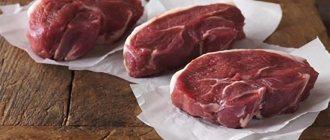What GOST and SanPiN say
Technologies for raising livestock do not stand still. The producer does not want to graze animals on pastures and fatten them for 1–1.5 years. Everyone wants quick results. The introduction of synthetic amino acids into the diet of animals affects their growth rate and the quality of meat.
GOST no longer undertakes to establish storage periods and conditions. Everything is left to the discretion of the manufacturer. However, GOST regulates recommended deadlines that cannot be exceeded.
The recommended shelf life of chilled meat (beef) packaged under vacuum at a temperature of -1 to 4 °C and a humidity of 85% is no more than 25 days from the date of slaughter. This period includes the ripening period of the product, which is at least 5 days.
Other periods and conditions are indicated in the table:
Conditions and terms of storage of raw meat according to GOST
When meat enters an enterprise that produces or sells perishable products, SanPiN comes into force. It regulates storage conditions at a temperature not exceeding 6 °C (as in a household refrigerator).
In this case, the storage periods will be as follows:
Shelf life of raw meat, semi-finished products and ready-made meat dishes according to SanPiN. Click on the image to enlarge (opens in a new window)
Do you know that…
Strict requirements are imposed on finished meat products. The microflora in such products develops very quickly. Storage periods are set in hours, no more.
Preparing meat for storage
A decrease in the quality of meat, the emergence of difficulties in the technological processing of carcasses, as well as a decrease in the level of stability of meat during storage of chilled meat or frozen meat products largely depends on the primary processing of livestock, this is:
- method of slaughtering animals;
- bleeding process;
- whitening and skinning;
- scalding and hitting the bristles;
- sawing;
- wet and dry toilet.
Thus, for cattle, the mechanical stunning method is preferable to avoid internal hemorrhages and bone fractures. Compared to electrical stunning, such meat has significantly higher organoleptic (color, taste, smell) and technological (elasticity, water-binding capacity) parameters.
At the same time, it is better to stun pigs using a carbon dioxide gas mixture, the effect of which causes anesthesia in the animal, general immobility and relaxation of all muscles. This ensures productive bleeding and reduces the risk of internal hemorrhages.
Incomplete bleeding gives the meat a darker shade, as well as the likelihood of microbiological spoilage, both when storing fresh meat and chilled meat. Poor-quality whitening and skinning not only causes poor presentation due to cuts and snatches, but also allows mold and putrefactive microorganisms to penetrate into the meat, causing spoilage of the meat.
How to choose fresh
Choosing fresh meat without experience is difficult. Skilled traders perform many manipulations to sell their stale goods. It is even more difficult to choose fresh meat that is not purchased very often. For example, rabbit, nutria, goat or moose.
To avoid mistakes, you can use the following recommendations:
- Externally, fresh meat should have a dry dry crust. If it is sticky and darkened, this indicates questionable freshness. The stale product is dark, gray-brown, very dried out.
- Fresh fat is light, white or yellowish, almost odorless. Beef crumbles, pork has a spreadable consistency. Old meat will have gray fat and a rancid smell.
- When cutting into the muscle, fresh meat will not leave a mark on the filter paper. A stale product will be sticky and will certainly leave a mark.
- The consistency of the steamed pulp is elastic. If you press, the muscles spring back and the dent quickly levels out. In case of questionable freshness, the dent is leveled out slowly, and the old one does not fill the hole left by the finger.
- The smell of a fresh product will be specific, characteristic of the animal species.
Tip of the day
They still don’t know how to change the smell of meat. Stale - smells sour, this is the result of the proliferation of acid-forming bacteria. Be sure to smell the product when purchasing. If you have doubts, don’t buy.
The broth will also help determine the freshness of the meat. If you boil a benign piece, the liquid you get will be:
- fragrant;
- transparent;
- with a small amount of small “flakes”.
Meat that creates turbidity and a sharp, unpleasant smell of broth is not fresh.
How to store raw food: terms, conditions, packaging
The refrigerator is a wonderful invention. However, this kitchen unit is young, and people have previously tried to preserve the product for as long as possible.
In the old days, salt and herbs and nettles were used as preservatives. However, nothing can compare to the cold
Interesting fact
You can store meat without a refrigerator, but only during its ripening period. Further, above-zero temperatures promote the proliferation of microflora and spoilage of the product.
How to prepare (does it need to be washed)
Meat brought from the market or store should not be washed. It is better to do this before cooking.
If you plan to cook the meat within 1-2 days, place it in a bag or container and place it in the refrigerator. If there is more product than needed, it is better to put it in the freezer.
In a refrigerator
The refrigerator is the only place for safe storage. The bottom shelf is best suited for this purpose. If you know exactly when livestock or, for example, a rabbit was slaughtered, then the storage period is determined from the moment of slaughter. This meat can be stored for 4–5 days.
If the moment of slaughter is unknown (the sticker on the package cannot always be trusted), then it is better not to store it for longer than 1–2 days.
In the freezer
Although there are shelf life limits for frozen meat, it is theoretically possible to store the product until defrosted. This is how strategic reserves are created for years. However, the longer meat sits in the freezer, the more tasteless it will be after defrosting and cooking.
Fresh meat should not be frozen. After slaughter, it is better to let it ripen and rest in the refrigerator for 1–2 days. Next, pack it in paper, a bag or container and put it in the freezer.
Note to the hostess
You can also freeze semi-finished products. Cut the piece into pieces, beat it, wrap it in portions and put it in the freezer.
After defrosting
It is better to defrost meat gradually. It needs to be removed from the chamber and moved to the refrigerator, where it can be stored for another day after complete defrosting until processing. Or put it in cold water.
But repeated freezing is unacceptable.
Without a refrigerator, on the road
Now there are thermal bags and thermal bags. If you don’t have such devices, you can use ice:
- Plastic bottles of water are frozen and placed in a container along with the meat.
- Then everything is well packaged.
Such storage is possible until the ice melts and the water begins to heat up. If the road is long, don’t take risks.
We recommend reading: Food thermal bags: 5 uses you didn’t know about.
[flat_ab id=”42"] [f[flat_ab id=”43"]p>
Various storage methods, tricks and inventions find no justification - meat without refrigeration quickly spoils
In a vacuum
Vacuum packaging is quite specific. Without knowing the conditions under which packaging was carried out, it is unrealistic to talk about storage times and conditions. Therefore, GOST leaves this to the discretion of the manufacturer. Only he knows:
- what they pack in;
- how and with what meat is processed;
- How does the microflora behave in the packaging?
The manufacturer receives all this knowledge on the basis of serious laboratory research. The results are taken into account and recorded in the specifications, which the manufacturer must follow.
It is important to know!
The packaging must indicate the date of manufacture or “use by”. This marking should be followed impeccably. However, after opening it is necessary to carry out an organoleptic analysis - to evaluate the smell.
Correct actions when turning off the lights
If the power outage was short-lived (about 2 hours), nothing will happen to the meat. If there is no light for a long time, the product will deteriorate. To extend the shelf life, do not open the refrigerator doors again. This allows you to maintain a cold temperature longer.
The meat is transferred to a glass, plastic or enamel bowl and covered with a paper towel. After this they are sent to the freezer.
If there was a warning about an extended blackout, for example, a day or longer, such methods will not help preserve the product. In this case, the meat is cut into small pieces and dipped generously in salt. After this, they are placed in layers in a jar. Sprinkle each layer with about 1 cm of salt. The jar is sent to a cool place. Salting allows you to preserve the product for several weeks.
How to store cooked food
Boiled
Boiled meat is an excellent product that is best eaten freshly cooked. However, if necessary, you can store boiled meat in the refrigerator for some time. It's better to do this without broth. It should be placed in a container with a lid.
The storage period should not exceed a day.
If it happens that there is a lot of excess meat, freeze it ready-made. Of course, this product will be far from a culinary masterpiece. But it’s difficult to get something outstanding from any frozen product.
You can freeze it in the same container or transfer it to a bag. Defrosting is carried out on the refrigerator shelf.
Stew
The cooked meat in the sauce is immediately transferred to the refrigerator after cooling.
- Store in the same pan where cooking took place for up to 36 hours.
- If the meat is transferred to another container, then no more than 24 hours.
Roast
Fried meat also doesn't last long in the refrigerator. It must be eaten within 24 hours. If this is not possible, freeze it. Defrost slowly in the refrigerator.
Note to the hostess
To prevent chapping, meat should be stored in a bag or container.
Smoked, dried, dried
How and for how long to store industrial smoked meat can only be said by the person who made it. This depends on the preservative used.
It is difficult to determine the quality of smoked meat. Modern chemical preservatives make the product beautiful and tasty, but it is very far from healthy
Read the label carefully. Only the manufacturer knows how the product was processed and how long it can be stored. If there is no such information, do not take risks - the deadline is 24 hours.
The same principles apply when determining how to store jerky and dried meats.
Pickled
Store marinated meat in the marinade until ready to cook. One day at room temperature and one day in the refrigerator. Remove from marinade and cook immediately.
We recommend reading:
How long can minced meat, fish, and vegetables be stored in the refrigerator? Rules for freezing and defrosting.
How long can raw and cooked chicken be stored in the refrigerator and freezer?
How to prepare and store lard: raw, salted, smoked.
conclusions
- The current GOST does not regulate, but simply recommends the terms and conditions for storing meat. The manufacturer himself sets these parameters for his products.
- When purchasing meat products, rely on your knowledge and sense of smell. Be sure to look, touch and smell. Do not buy a questionable product.
- The refrigerator is the only suitable place to store meat products. For short-term storage, use the refrigerator, for long-term storage, use the freezer.
- Ready-made meat dishes are best consumed immediately after cooking. Storing in the refrigerator, and especially freezing, negatively affects their taste.
- Knowing the storage conditions will help you preserve, prepare and consume meat with the greatest benefit for the body.
Store correctly and be healthy!
Types of refrigeration treatment
Meat is a favorable environment for the proliferation of microorganisms, so it spoils very quickly. Cold processing allows you to preserve meat products for a long time and transport them if necessary. At low temperatures, most microorganisms die, and the part that remains ceases to be dangerous.
Types of cold treatment:
- Cooling. To do this, use fresh or cooled meat from recently slaughtered animals. It is placed in refrigeration chambers with temperatures ranging from 0 to -4°C. When cooled, a dried crust forms on the surface. This product is used for sale or subsequent freezing.
- Freezing. This method is used for long-term storage. The product is frozen in blocks, quarters, half-carcasses and carcasses. The temperature in the freezing chambers is from -23 to -35°C.










